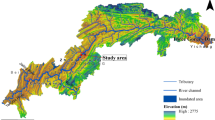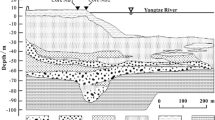Abstract
The sedimentation rates and diffusive sediment mixing coefficients at several Lake Ontario locations have been derived from measurements of unsupported210Pb profiles in sediment cores. The values of mixing coefficients obtained in the present study are significantly lower than those obtained previously through an analysis of porosity profiles. The present estimates, however, are consistent with the rather well-preserved pollutant profiles at some of these locations. It is observed that the more realistic value of the mixing coefficient, obtained by inclusion of the sedimentation rate parameter, follows the sign opposite to that for the constant obtained by regression analysis of the porosity data. Further work is required to delineate this apparent relationship between two important physical characteristics of deposited sediments.
Analysis of available suspended sediment data shows that Niagara River supplies about 1.8 million tonnes of sediment annually to Lake Ontario. This value is significantly lower than that (4.6 mt/yr) used previously in constructing sediment and pollutant budgets for Lake Ontario. From the presently derived sedimentation rate and suspended solid discharge estimates, an average value of 441 km2 (range 220-938 km2) is obtained for the minimum area of Lake Ontario over which the Niagara River-supplied fine sediment is deposited.
Similar content being viewed by others
References Cited
Bukata, R. P., and A. G. Bobba, 1984, Determination of diffusion coefficients associated with the transport of210Pb radionuclide in lake bed sediments: Environmental Geology, v. 5, no. 3, p. 133–141.
Durham, R. W., and S. R. Joshi, 1980, Recent sedimentation rates,210Pb fluxes and particle settling velocities in Lake Huron, Laurentian Great Lakes: Chemical Geology, v. 31, p. 53–66.
Durham, R. W., and B. G. Oliver, 1983, History of Lake Ontario contamination from the Niagara River by sediment radiodating and chlorinated hydrocarbon analysis: Journal of Great Lakes Research, v. 9, no. 2, p. 160–168.
Environment Canada, 1985, Historical streamflow summary to 1984—Ontario: Inland Waters Directorate, Water Resources Branch, Water Survey of Canada, Ottawa, p. 311.
International Joint Commission, 1969, Pollution of Lake Erie, Lake Ontario and the international section of the St. Lawrence River, Vol. 3, Lake Ontario and the international section of the St. Lawrence River: International Joint Commission, Windsor, Ontario, Canada, p. 220.
Joshi, S. R., 1985, Recent sedimentation rates and210Pb fluxes in Georgian Bay and Lake Huron: Science of the Total Environment, v. 41, p. 219–233.
Joshi, S. R., 1987, Nondestructive determination of lead-210 and radium-226 in sediments by direct photon analysis: Journal of Radioanalytical and Nuclear Chemistry, Articles, v. 116, no. 1, p. 169–182.
Joshi, S. R., 1988a, West Valley-derived radionuclides in the Niagara River area of Lake Ontario: Water, Air, and Soil Pollution, v. 37, p. 111–120.
Joshi, S. R., 1988b, West Valley plutonium and americium-241 in Lake Ontario sediments off the mouth of Niagara River: Water, Air, and Soil Pollution, v. 42, p. 159–168.
Joshi, S. R., 1989, Common analytical errors in the radiodating of recent sediments: Environmental Geology and Water Sciences, v. 14, no. 3, p. 203–207.
Joshi, S. R., and A. G. Bobba, 1989, Estimation of mixing rates in western Lake Ontario sediments by finite element analysis of210Pb profiles: Environmental Geology and Water Sciences, v. 13, no. 3, p. 195–200.
Joshi, S. R., and B. S. Shukla, 1991, Ab initio derivation of formulations for210Pb dating of sediments: Journal of Radioanalytical and Nuclear Chemistry, Articles, v. 148, no. 1, p. 73–79.
Joshi, S. R., B. S. Shukla, and R. McNeely, 1988, The calculation of lead-210 dates for McKay Lake sediments: Journal of Radioanalytical and Nuclear Chemistry, Articles, v. 125, no. 2, p. 341–349.
Kemp, A. L. W., and N. S. Harper, 1976, Sedimentation rates and a sediment budget for Lake Ontario: Journal of Great Lakes Research, v. 2, no. 2, p. 324–340.
Krishnaswami, S., and D. Lal, 1978, Radionuclide limnochronology;in A. Lerman, ed., Lakes, Chemistry, Geology and Physics: New York, Springer-Verlag, p. 153–177.
U.S. Geological Survey, 1975–1978, All reports in this series are entitled “Water Resources Data for New York” and subtitled (numbered) as “Water Year 1975” (NH-75-1) and so on, U.S. Geological Survey, Albany, New York.
Van Hoof, P. L., and A. W. Andren, 1989, Partitioning and transport of210Pb in Lake Michigan: Journal of Great Lakes Research, v. 15, no. 3, p. 498–509.
Author information
Authors and Affiliations
Rights and permissions
About this article
Cite this article
Joshi, S.R., Shukla, B.S. & Bobba, A.G. Lead-210 sedimentation in Lake Ontario. Environ. Geol. Water Sci 19, 121–126 (1992). https://doi.org/10.1007/BF01797440
Issue Date:
DOI: https://doi.org/10.1007/BF01797440




